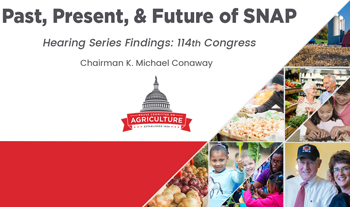 Nutrition Assistance Program (SNAP). Committee members heard from 60 witnesses in 16 hearings over the course of the review known as the Past, Present, and Future of SNAP. The report can be viewed here.
Nutrition Assistance Program (SNAP). Committee members heard from 60 witnesses in 16 hearings over the course of the review known as the Past, Present, and Future of SNAP. The report can be viewed here.SNAP has grown from a pilot program that served just 500,000 people in 1964 to a program that served more than 47 million Americans at the height of the recession. SNAP is now the largest program under the Agriculture Committee’s jurisdiction—accounting for almost 80 percent of farm bill spending—and is the largest federal food program serving low-income families in the United States.
“Every day, more than 43 million Americans rely on SNAP to put food on the table for themselves and their families. Over the past two years, we have found that the program is working well in many areas, but there are a number of areas in need of improvement. The findings in this report will guide our efforts as we prepare to reauthorize SNAP in the 115th Congress,” said Chairman Conaway. “Over the past two years, it was clear that there is sincere, bi-partisan interest in ensuring that SNAP is meeting the needs of those it is intended to serve. I want to thank all of my colleagues—including Nutrition Subcommittee Chairwoman Jackie Walorski, Ranking Member Collin Peterson, and Nutrition Subcommittee Ranking Member Jim McGovern—for their patience and perseverance as we undertook this top-to-bottom review. I also want to again thank the many witnesses who took time out of their busy schedules to make their voices heard.”
“I’ve seen hunger and poverty up close, both overseas and in my district, and I know the importance of working together to end the cycle of poverty. This report is the result of two years of listening to those who are on the front lines of the fight against poverty and those who have faced hardship themselves. By understanding what works and what doesn’t, we can better help those who fall on hard times so everyone has a chance to achieve the American Dream. I want to thank Chairman Conaway, Nutrition Subcommittee Ranking Member Jim McGovern, and our colleagues on the Agriculture Committee for their hard work that has set the stage for real reforms to fix the way we fight poverty,” said Subcommittee Chairwoman Jackie Walorski (R-IN).
Source: House Committee on Agriculture
Also a Statement by Agriculture Secretary Tom Vilsack on House Agriculture Committee Report on SNAP
WASHINGTON - Agriculture Secretary Tom Vilsack released in December the following statement on the House Committee on Agriculture's new report on the Supplemental Nutrition Assistance Program (SNAP), which contains the Committee's findings from a series of hearings on the program:"After holding 16 hearings on SNAP over the past two years, the House Agriculture Committee reached a simple conclusion: SNAP provides a critical nutrition safety net for millions of low-income Americans, and we need to do all we can to protect and strengthen the program so it can continue effectively serving American families in need.
"Four out of five SNAP participants are children, seniors, people with disabilities, or working adults. SNAP reduces food insecurity, increases access to healthy food, and generates economic activity and creates jobs all along the supply chain—from the store where food is purchased, all the way back to the farmer who produces it. The program has also been shown to have a positive impact on children's health, academic performance, and long-run economic self-sufficiency. SNAP rewards work with benefits that decrease gradually as earnings increase, and SNAP Employment & Training helps participants build the skills they need to get good-paying jobs and move off the program the right way.
"SNAP is designed to respond swiftly to changing economic conditions—on a national scale, as we saw during the Great Recession when SNAP lifted millions of people out of poverty, or locally, when a plant closes, disaster strikes, or another event causes sudden unemployment or hardship in a particular community. As the report highlights, states already have significant flexibility to tailor the program to their unique needs, while maintaining the responsiveness, effectiveness, and oversight of the Federal program.
"Proposals to convert SNAP into a block grant are misguided and would mean the program could no longer respond to economic conditions and serve all eligible Americans without drastically reducing benefits. As Congress begins working on the 2018 Farm Bill, they must protect SNAP and resist pressure to weaken the program by turning it into an ineffective block grant."
Source: USDA








